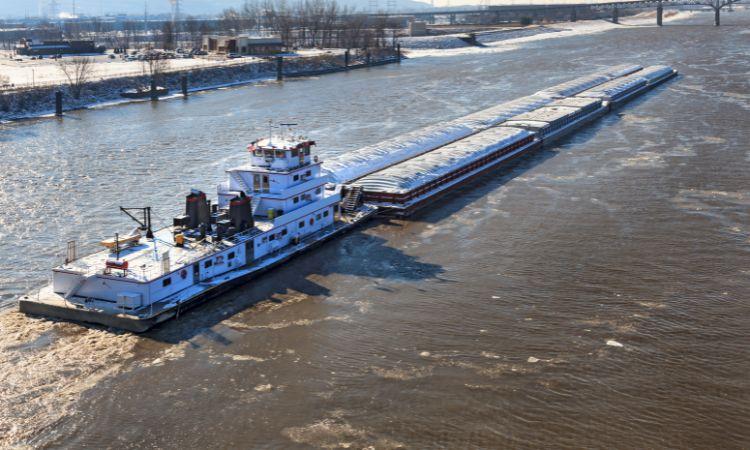The global barge transportation market size reached a value of around USD 140.22 billion in 2023. The market is further expected to grow at a CAGR of 3.5% in the forecast period of 2024-2032 to attain a value of about USD 190.86 billion by 2032. In the ever-evolving world of logistics and freight shipping, finding efficient and sustainable transportation methods is a constant pursuit for businesses and industries around the globe. One such method that often flies under the radar but holds immense promise is barge transportation. In this article, we will explore the myriad advantages that barge transportation offers for freight shipping, shedding light on how it not only reduces costs but also contributes to a greener and more reliable supply chain.
I. Cost Efficiency
When it comes to moving goods from one place to another, cost efficiency is a paramount concern for businesses. Barge transportation stands out in this regard, offering several compelling advantages:
Lower Fuel Costs Compared to Trucking
One of the primary cost advantages of barge transportation is its significantly lower fuel consumption when compared to traditional trucking. Barges are powered by engines that are optimized for fuel efficiency, making them an economical choice for long-distance shipping. Unlike trucks that are subject to frequent fuel stops and refueling, barges can transport goods over extensive distances without the need for constant refills.
Reduced Labor Costs Due to Large Cargo Capacity
Another cost-saving aspect of barge transportation is its ability to transport goods in large quantities. Barges are designed to carry massive cargo loads, often exceeding what a fleet of trucks could transport in one trip. This means that businesses can move more goods with fewer labor resources, reducing labor costs significantly.
Economies of Scale in Shipping Bulk Goods
Barges are particularly well-suited for transporting bulk goods such as coal, grain, and raw materials. Due to their vast cargo capacity, they enable businesses to leverage economies of scale, resulting in lower per-unit transportation costs. This advantage becomes especially crucial when dealing with commodities that are produced or consumed in large quantities.
II. Environmental Benefits
In today’s environmentally conscious world, businesses are increasingly looking for sustainable transportation options. Barge transportation offers several notable environmental benefits:
Reduced Carbon Emissions Compared to Other Transportation Modes
One of the most significant environmental advantages of barge transportation is its lower carbon footprint when compared to other modes of transportation, such as trucks or airplanes. Barges emit fewer greenhouse gases per ton-mile of cargo transported, contributing to a reduction in overall carbon emissions from the transportation sector.
Preservation of Road Infrastructure
As more goods are transported by barge, there is less wear and tear on our road infrastructure. Heavy trucks, especially those carrying oversized or overweight loads, can cause significant damage to roads and bridges. By shifting some of this cargo to barges, we can extend the lifespan of our road infrastructure and reduce the maintenance costs borne by taxpayers.
Contribution to Sustainable Shipping Practices
Barge transportation aligns with the broader goals of sustainable shipping practices, which emphasize reducing environmental impact and conserving resources. This mode of transportation utilizes existing waterways, minimizing the need for additional infrastructure construction. Additionally, it reduces the risk of oil spills associated with maritime shipping, further enhancing its sustainability credentials.
III. Reliable and Predictable Schedules
In the world of logistics, meeting delivery deadlines is crucial for businesses and customer satisfaction. Barge transportation offers reliability and predictable schedules due to various factors:
Minimal Traffic Congestion on Waterways
Unlike highways that can become congested with traffic, waterways typically experience fewer traffic-related delays. Barges navigate on rivers, canals, and other water bodies with fewer obstacles, resulting in smoother and more predictable journeys. This reduces the likelihood of shipments being delayed due to traffic jams or accidents.
Consistent Transit Times for Inland Water Routes
Inland waterways, where barges often operate, have well-established routes with known transit times. This predictability allows businesses to plan their shipments with confidence, knowing when goods will arrive at their destinations. This is particularly valuable for industries that rely on just-in-time inventory management.
Less Susceptibility to Weather-Related Delays
While adverse weather conditions can disrupt various modes of transportation, barges are generally less susceptible to weather-related delays. They have a lower profile than ships, making them more stable in rough waters. Additionally, they can often continue operating in conditions that would force other vessels to stay in port, ensuring goods keep moving even during inclement weather.
IV. High Cargo Capacity
Barge transportation’s ability to handle large cargo volumes is a defining feature that offers several advantages:
Explanation of the Large Cargo Capacity of Barges
Barges are designed with spacious cargo holds that can accommodate substantial quantities of goods. These vessels come in various sizes and configurations, allowing businesses to choose the most suitable barge for their cargo needs. From standard dry cargo barges to specialized vessels for oversized items, there is a barge for nearly every type of freight.
Suitable for Transporting Bulk Commodities like Coal, Grain, and Raw Materials
Bulk commodities, such as coal, grain, and raw materials, are well-suited for transportation by barge. These goods often need to be transported in large quantities, and barges offer the necessary capacity. For example, a single barge can transport thousands of tons of grain or coal, making it an efficient choice for industries that rely on these commodities.
Versatility for Oversized and Heavy Cargo
Barges aren’t limited to bulk commodities. They are also versatile enough to accommodate oversized and heavy cargo, such as machinery, construction equipment, or components of infrastructure projects. The ability to move such large items on barges can simplify logistics and reduce the need for costly and time-consuming disassembly and reassembly.
V. Safety Measures and Regulations
Safety is paramount in any mode of transportation, and barge transportation is no exception. Various safety measures and regulations are in place to ensure the secure movement of goods:
Overview of Safety Protocols in Barge Transportation
Barge operators adhere to strict safety protocols to minimize the risk of accidents and ensure the safety of crew members and cargo. These protocols include regular vessel inspections, maintenance checks, and adherence to navigational guidelines.
Importance of Compliance with Navigation Rules
Navigating waterways requires a thorough understanding of navigation rules and regulations. Barge operators must comply with these rules to prevent collisions, grounding, or other accidents. This compliance ensures the safe and efficient movement of barges on water routes.
The Role of Regulatory Bodies in Ensuring Safety
Regulatory bodies, such as the United States Coast Guard (USCG) in the United States, play a crucial role in overseeing and regulating barge transportation safety. They conduct inspections, enforce safety standards, and respond to emergencies to protect both the environment and public safety.
VI. Case Studies
Real-world examples illustrate the practical benefits of barge transportation:
Real-World Examples of Successful Freight Shipping via Barges
Several industries have successfully embraced barge transportation as a cost-effective and efficient solution for their shipping needs. For instance, the agriculture industry frequently relies on barges to transport grains, such as corn and soybeans, from Midwest farms to export terminals. This has resulted in significant cost savings and reliable transportation for agricultural businesses.
Highlighting Industries That Benefit from Barge Transportation
Beyond agriculture, various industries benefit from barge transportation. These include the energy sector, where barges transport oil, gas, and other energy resources, as well as construction and manufacturing industries that utilize barges to move heavy machinery and materials.
Quantifiable Cost and Time Savings Achieved in Specific Cases
In specific case studies, businesses have reported substantial cost and time savings by utilizing barge transportation. By examining these examples, we can gain a deeper understanding of the practical advantages and outcomes associated with barge shipping.
VII. Challenges and Considerations
While barge transportation offers numerous advantages, it’s essential to be aware of the challenges and considerations:
Discussing Challenges Such as Limited Navigable Waterways
Barge transportation is not without its challenges. One significant limitation is the availability of navigable waterways. Not all regions have access to suitable water routes, limiting the feasibility of barge transportation for some businesses.
Maintenance and Infrastructure Requirements
Maintaining and upgrading waterway infrastructure is an ongoing challenge. Dredging, for example, is necessary to maintain waterway depth, ensuring that barges can navigate without issues. Investment in such infrastructure is essential to support the growth of barge transportation.
Considerations for Businesses Considering Barge Transportation
Businesses considering barge transportation must carefully assess their specific needs and circumstances. Factors such as the location of their facilities, the nature of their cargo, and the availability of water routes all influence the suitability of barge transportation.
VIII. Future Trends and Innovations
The world of transportation is continuously evolving, and barge transportation is no exception. Several future trends and innovations are shaping the industry:
Emerging Technologies in Barge Transportation
Advancements in technology are transforming barge transportation. Automation and digitalization are becoming increasingly prevalent, improving efficiency and safety. For example, autonomous navigation systems are being developed to enhance the precision and reliability of barge movements.
Automation and Digitalization in Cargo Tracking and Management
Automation isn’t limited to navigation alone. Cargo tracking and management systems are becoming more sophisticated, providing real-time visibility into the status and location of shipments. This level of transparency benefits both shippers and customers, reducing uncertainty and enhancing overall supply chain management.
Sustainable Initiatives in the Barge Industry
The push for sustainability extends to the barge transportation industry. Companies are exploring alternative fuels, such as liquefied natural gas (LNG), to power barges, reducing emissions even further. Additionally, efforts to minimize the environmental impact of barge transportation, such as improved waste management practices, are gaining traction.



